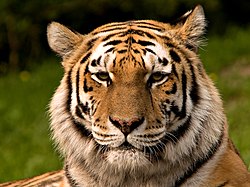Siberian tiger: Difference between revisions
No edit summary |
No edit summary |
||
| Line 21: | Line 21: | ||
| range_map_width = 250px |
| range_map_width = 250px |
||
}} |
}} |
||
The '''Siberian |
The '''Siberian Tiger tim sucks onm dick |
||
''' (''Panthera tigris altaica'') is a rare [[subspecies]] of [[tiger]] (''P. tigris''). Also known as the '''Amur''', '''North China''', '''Manchurian''', '''Ussuri''', or '''Korean Tiger,''' it is arguably the largest of the 6 [[extant]] tiger subspecies. |
''' (''Panthera tigris altaica'') is a rare [[subspecies]] of [[tiger]] (''P. tigris''). Also known as the '''Amur''', '''North China''', '''Manchurian''', '''Ussuri''', or '''Korean Tiger,''' it is arguably the largest of the 6 [[extant]] tiger subspecies. |
||
==Physical features== |
==Physical features== |
||
Revision as of 23:07, 8 November 2007
| Siberian Tiger | |
|---|---|

| |
| Scientific classification | |
| Kingdom: | |
| Phylum: | |
| Class: | |
| Order: | |
| Family: | |
| Subfamily: | |
| Genus: | |
| Species: | |
| Subspecies: | P. tigris altaica
|
| Trinomial name | |
| Panthera tigris altaica Temminck, 1884
| |

| |
| Distribution of the Siberian Tiger (in red) | |
The Siberian Tiger tim sucks onm dick (Panthera tigris altaica) is a rare subspecies of tiger (P. tigris). Also known as the Amur, North China, Manchurian, Ussuri, or Korean Tiger, it is arguably the largest of the 6 extant tiger subspecies.
Physical features
The Siberian tiger is typically only 2-4 inches taller at the shoulder than the Bengal Tiger, which is about 107-110 cm. tall.[1] Old Males reach normally a head and body length of 190-220 centimetres (75-97 in). The largest male with largely assured references was 350 cm (138 in) "over curves" (3,30 m. between shoulders) in total length.[2] (The tail length in old males is about one metre.) Apart from its size, the Siberian Tiger is differentiated from other tiger subspecies by its paler fur and dark brown (rather than black) stripes. As well as for colour, their fur also differs by being thicker and longer in order to cope with the freezing temperatures of their habitat. Siberian Tigers vary, too, by having larger feet than most other sub-species to help facilitate movement through snow.
Although male Siberian Tigers commonly weigh up to 270 kilograms,[3] an average male weighs around 200-230 kg. Weights up to 306 kg have been recorded and exceptionally large males of up to 384 kg are mentioned in the literature but, according to Mazak, none of these cases were confirmed via reliable sources.[2] Females are normally smaller than males and weigh 100-167 kg,[4] probably up to 180 kg (390 lb).[5] The "Siberian Tiger Project", which has operated from Sikhote-Alin Zapovednik since 1992, found that 215 kg seemed to be the largest that they were able to verify, albeit from a limited number of specimens.[6] At least one authority suspects that this is the difference between real weights and hunter's estimates.[1] Dale Miquelle, program director of the Siberian Tiger Project, writes that, despite repeated claims in the popular literature that the Siberian is the largest of all tigers, their measurements on more than fifty captured individuals suggest that body size is, in fact, similar to that of Bengal tigers.[7]
Distribution and population
The Siberian Tiger is critically endangered. In the early 1900s, it lived throughout the northeastern China, Korean Peninsula, northeastern Mongolia and southeastern Russia. In 1922 they died out from South Korea (then under Japanese rule) and today, it is very rare in North Korea and is largely confined to a very small part of Russia's southern Far East (the Amur-Ussuri region of Primorsky and Khabarovsky Krai).[citation needed] There are very few tigers in northeastern China and fewer still in North Korea. Captive breeding and conservation programs are currently active.[citation needed]

By the 1940s the estimated population was down to fewer than 50 in the Russian Far East, although some hundreds still populated neighbouring China. [8] The number increased to more than 200 in 1982, although in China there are now thought to be no more than a dozen or so Amur tigers. Poaching has been brought under better control due to frequent road inspections.
A count, taken in 1996 reported 430 Siberian Tigers in the wild. However, Russian conservation efforts have led to a slight increase, or at least to a stable population of the subspecies, as the number of individuals in the Siberian Forests was estimated between 431 and 529 in the last count in 2005.[9] According to the World Wide Fund for Nature, the latest Russian Census reports put this number to be anywhere between 480 and 520 without including the small numbers of this subspecies present in mainland China.[10] The Hengdaohezi Feline Breeding Centre in the northern Heilongjiang province of China plans to release 620 Siberian tigers, after its numbers have increased from 708 to 750.[11]
Breeding

Siberian tigers reach sexual maturity when they are 3 years old male and female. They mate any time of the year. A female shows that she is ready by leaving urine deposits and scratch marks on trees. The female is receptive for 3 of the 7 days that she will spend with the male while they are mating. The female when pregnant carries the cubs for 3-3 1/2 months. They usually have a litter with 3-4 cubs but they can have as many as 6 cubs in one litter. The cubs are born blind in a sheltered den to keep them protected while the mother goes and hunts for food.
Diet
Like all other cats, the Siberian Tiger is a carnivorous predator; an adept hunter, it preys primarily on wild boar and red deer. Both species make up 65-90% of its diet in the Russian Far East. Other important prey species are moose, roe deer, sika deer, musk deer and goral. Even dangerous animals like adult brown bears are among the prey species of the Siberian tiger. Asiatic black bears and brown bears constitute 5-8% of the Siberian tigers diet,[2] but it will also take smaller prey like lagomorphs (hares, rabbits, and pikas) and fish, including salmon. Because its main prey are red deer and wild boar, protecting these and other prey animals from illegal hunting may be just as important to the tiger's survival as preventing direct killing of the big cats.
Tigers will occasionally kill wolves to remove competition over their limited prey base.[12][13]Thus, where there are more tigers, the wolves cease to exist.[12]
Captivity

The captive population of Siberian Tiger comprises several hundred. A majority of these tigers are found in China, with other populations in Europe and North America. The large, distinctive and powerful cats are popular zoo exhibits. The Siberian Tiger is bred within the Species Survival Plan (SSP), a project based on 83 wild caught tigers. According to most experts, this population is large enough to stay stable and genetically healthy. Today, approximately 160 Siberian Tigers participate in the SSP, which makes it the most extensively bred tiger subspecies within the programme. There are currently no more than around 255 tigers in the tiger SSP from three different subspecies. Developed in 1982, the Species Survival Plan for the Siberian Tiger is the longest running program for a tiger subspecies. It has been very fortunate and productive, and the breeding program for the Siberian Tiger has actually been used as a good example when new programs have been designed to save other animal species from extinction.
The Siberian Tiger is not very difficult to breed in captivity, but the possibility of releasing animals bred in captivity into the wild is small. Conservation efforts that secure the wild population are therefore still of imperative. If a captive bred Siberian Tiger were to be released into the wild, it would lack the necessary hunting skills and starve to death. Captive bred tigers can also approach humans and villages, since they have learned to associate humans with feeding and lack the natural shyness of the wild tigers. In a worst-case scenario, the starving tigers could even become man-eaters. Since tigers must be taught how to hunt by their mothers when they are still cubs, a program that aimed to release captive bred Siberian Tigers into the wild would face great difficulties.
Trivia
This article contains a list of miscellaneous information. (November 2007) |
- Hodori, an Amur Tiger cub, was chosen as the mascot for the 1988 Summer Olympics.
- Olga, a Siberian Tigress, was the first radio-collared Siberian tiger and went on to become the most long and intensively studied wild tiger in the world. At 14 years of age and after bearing as many as 13 cubs she went missing, presumably she was poached. [2]
Gallery
-
A tiger at the Henry Doorly Zoo
-
A tiger in St. Louis Zoo
-
Eye of the tiger
-
Amur tigers at Marwell Zoological Park
References
- ^ a b Matthiessen, Peter (2001). Tigers In The Snow. North Point Press. ISBN 0865475962.
{{cite book}}: Unknown parameter|coauthors=ignored (|author=suggested) (help) - ^ a b c Vratislav Mazak: Der Tiger. Nachdruck der 3. Auflage von 1983. Westarp Wissenschaften Hohenwarsleben, 2004 ISBN 3 894327596
- ^ Turner, Alan (1997). The big cats and their fossil relatives. Columbia University Press. ISBN 0-231-10229-1.
{{cite book}}: Unknown parameter|coauthors=ignored (|author=suggested) (help) - ^ Ronald M. Nowak: Walker's Mammals of the World. Johns Hopkins University Press, 1999 ISBN 0-8018-5789-9
- ^ Sunquist, Mel (2002). Wild Cats of the World. Chicago: University Of Chicago Press. ISBN 978-0-226-77999-7.
{{cite book}}: Unknown parameter|coauthors=ignored (|author=suggested) (help) - ^ Prynn, David (2002). Amur Tiger. Russian Nature Press. ISBN 0953299031.
- ^ Thapar, Valmik (2004). Tiger: The Ultimate Guide. CDS Books. ISBN 1593150245.
- ^ [1]
- ^ "Siberian Tigers Stable, According to Landmark Survey". National Geographic. 2005-06-16. Retrieved 2007-02-26.
{{cite web}}: Check date values in:|date=(help) - ^ "World's biggest tiger winning extinction fight". The Telegraph. 2007-04-14. Retrieved 2007-07-02.
{{cite web}}: Check date values in:|date=(help) - ^ "Baby boom for endangered tigers". BBC News. 2007-06-17. Retrieved 2007-06-18.
{{cite web}}: Check date values in:|date=(help) - ^ a b "The IUCN-Reuters Media Awards 2000". IUCN. Retrieved 2007-08-17.
- ^ "Amur Tiger". Save The Tiger Fund. Retrieved 2007-08-17.
General references
- Template:IUCN2006 Database entry includes a brief justification of why this subspecies is critically endangered and the criteria used
- "Russian Plan to Save World's Largest Tiger Succeeds". Environment News Service. US: Environment News Service.
{{cite web}}: Unknown parameter|accessmonthday=ignored (help); Unknown parameter|accessyear=ignored (|access-date=suggested) (help) - Seidensticker, John (1999). Riding the Tiger. Tiger Conservation in Human-dominated Landscapes. Cambridge University Press. ISBN 0521648351.
- Chamberlain, Ted (2007-04-16). "Photo in the News: Biggest Tiger Pounces Back From Brink". National Geographic.
{{cite web}}: Check date values in:|date=(help)
External links
- Amur (Siberian) tiger at WWF
- Save China's Tiger homepage, information regarding the rewilding project
- Siberian Tiger Profile at National Geographic
- Wildlife Conservation Society's Siberian Tiger Project
- AMUR - Preserving leopards and tigers in the wild
- Information Resources on Tigers, Panthera tigris: Natural History, Ecology, Conservation, Biology, and Captive Care, AWIC Resource Series No. 34, April 2006, Compiled by: Jean Larson, Animal Welfare Information Center, USDA, ARS, NAL, 10301 Baltimore Avenue, Beltsville, MD 20705, USA. E-mail: awic@nal.usda.gov





